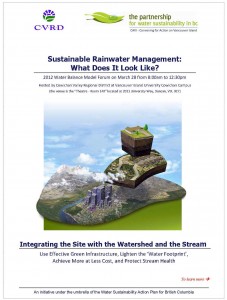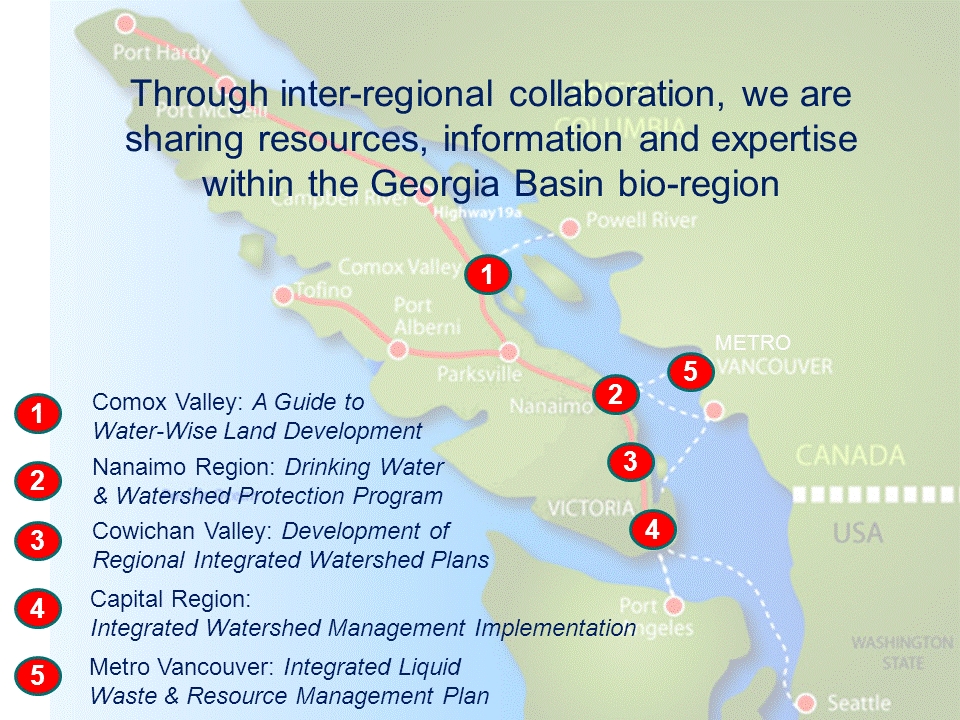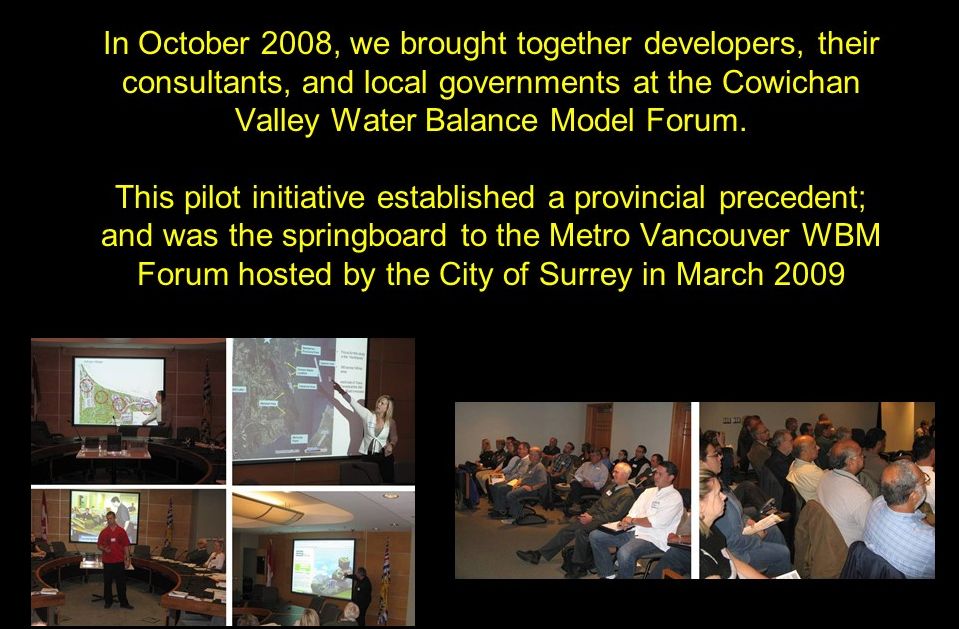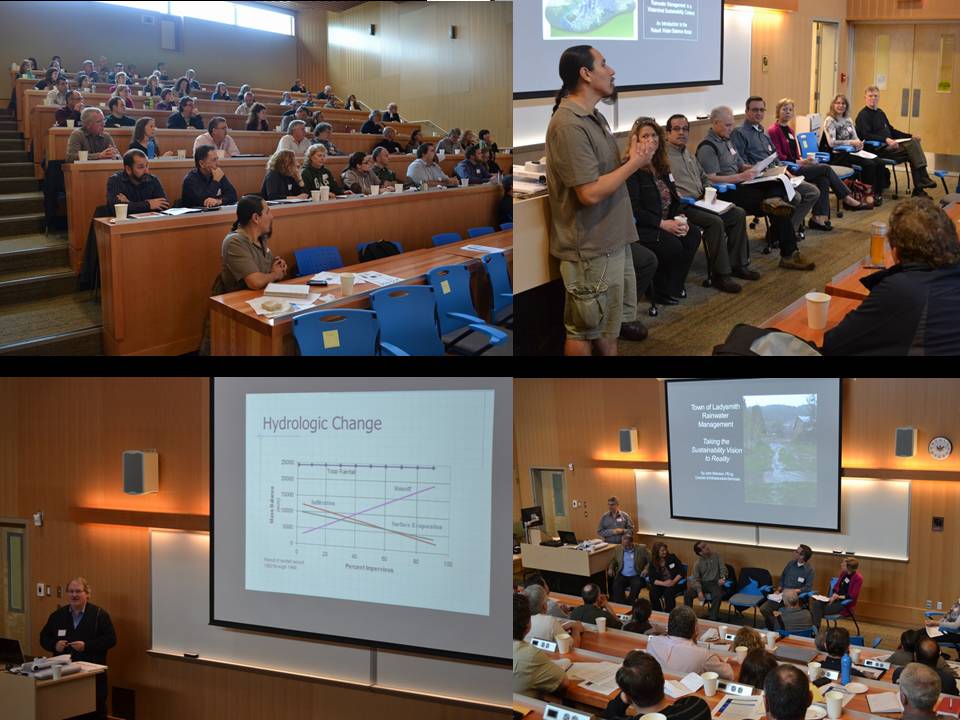FLASHBACK TO 2012: “Georgia Basin Inter-Regional Educational Initiative” launched at inter-regional Water Balance Forum hosted by Cowichan Valley Regional District (March 2012)
Sustainable Rainwater Management: What Does It Look Like?
Land development practices and actions at the site scale can result in either impacts or benefits at the local and watershed scales.
Application of the Water Balance Methodology holds the key to protecting stream health because it accounts for all the rainfall-days in a year. This methodology is a foundation block for those tasked with developing an Integrated Stormwater Management Plan (ISMP).
Historical Context
“In 2008, the Cowichan Valley was the first demonstration region for the initial rollout of Living Water Smart, British Columbia’s Water Plan, and also hosted the inaugural Vancouver Island Water Balance Model Forum,” reports Kate Miller of the Cowichan  Valley Regional District.
Valley Regional District.
At the time, Kate was Manager of the Regional Environmental Policy Division. She has been proactive in her efforts to integrate rain, storm and stream management at multiple scales in the region using a ‘design with nature’ approach to infrastructure.
Inaugural event for Georgia Basin Inter-Regional Educational Initiative
“In March 2012, the Cowichan Valley again hosted a WBM Forum. Our venue was a LEED facility on the Duncan campus of Vancouver Island University.”
“The Forum was the kick-off for an Inter-Regional Education Initiative to be implemented in four regions over several years. Sharing of experiences, collaboration, alignment and a consistent approach on Vancouver Island will allow everyone to go farther, more efficiently and effectively.”
“Five local governments comprising the Cowichan Valley Regional Team reported out on how each has progressed since 2008. Our emphasis was on ‘targets and criteria’, lessons learned, and practices necessary to protect stream health.”
“Regulatory agencies and other local governments also shared their insights at the Water Balance Forum.”
Inter-Regional Representation
The Forum attracted representatives from 29 organizations, including the City of Calgary.
The Inter-Regional Education Initiative is bringing together local governments from Metro Vancouver and four regions on the east coast of Vancouver Island: Capital Region, Cowichan Valley, Nanaimo Region and Comox Valley.
Agenda
Click on Sustainable Rainwater Management: What Does It Look Like? to download a copy of the Agenda.
Rainwater Management in the Cowichan Valley (Hour #1):
In 2008, the Cowichan Valley was the first demonstration region for the initial rollout of Living Water Smart, and also hosted the inaugural Vancouver Island WBM Forum. The five local governments comprising the Cowichan Valley Regional Team reported out.
Rainwater Management in Central Saanich (Hour #2):
The municipality has an award-winning ISMP (Integrated Stormwater Management Plan) and Surface Water Management Bylaw, adopted in Feb 2010. The bylaw requires rainwater capture, encourages use of the WBM, and gives Central Saanich the means to restore the water balance as and when properties redevelop. David McAllister and Roland Rocheleau reported out on their implementation experience.
Rainwater Management in a Watershed Sustainability Context (Hour #3):
Four regional districts are embarking upon an Inter-Regional Education Initiative. Sharing of experiences, collaboration, alignment and consistency will allow everyone to go farther, more efficiently and effectively. Representatives of MOE, DFO and MOTI elaborated on regulatory requirements that provide a driver for local governments to protect and/or restore watershed health over time.

An Introduction to the Water Balance Model (Hour #4):
Rebuilt on a new platform, the WBM is quicker and easier to use; and has launch buttons at three scales: SITE, NEIGHBOURHOOD and WATERSHED. Jim Dumont explained the science behind the methodology; demonstrate how to establish and assess performance targets; and showcase modules for stream erosion, rainwater harvesting, climate adaptation, tree canopy interception, infrastructure assessment.
Links to PowerPoint Presentations
 Rainwater Management in the Cowichan Valley (13.3MB PDF)
Rainwater Management in the Cowichan Valley (13.3MB PDF)
Rainwater Management in Langford & Ladysmith (4.9MB PDF)
Rainwater Management in Central Saanich (5.8MB PDF)
Rainwater Management in a Watershed Context (2.4MB PDF)
An Introduction to the Water Balance Model (5.0MB PDF)
Cowichan Water Balance Forum – closing segment (0.2MB PDF)
To learn More:
To read a set of supporting stories posted on the Vancouver Island community-of-interest, click on Cowichan Valley Water Balance Model Forum.
Mimic the Water Balance to Protect Stream Health: What Does that Mean, Really?
 “The Cowichan Forum provided us with a teachable moment to focus our local government colleagues on what it means in practice to mimic the Water Balance,” reports Kim Stephens, Partnership Executive Director.
“The Cowichan Forum provided us with a teachable moment to focus our local government colleagues on what it means in practice to mimic the Water Balance,” reports Kim Stephens, Partnership Executive Director.
“A critical take-away message was the need for everyone to shine their spotlights on the Water Balance Methodology. This is the priority. The Water Balance Model is simply the means to achieve an outcome.”
Water Balance Methodology
“The Water Balance Methodology holds the key to protecting stream health because it integrates the site with the watershed and the stream.”
“The methodology accounts for all the rainfall-days in a year. The methodology links rain that falls on a site…to the runoff leaving the site…to the flow in a stream.”
“This methodology is a foundation block for those tasked with developing a master drainage plan or a rainwater management plan.”
Look at Rainfall Differently
A decade ago, looking at rainfall differently led the Province of BC to develop the Water Balance Methodology, and initiate a paradigm-shift in the way rainwater is managed:
 The Province formalized the performance target methodology in Stormwater Planning: A Guidebook for British Columbia, a provincial guidance document released in 2002.
The Province formalized the performance target methodology in Stormwater Planning: A Guidebook for British Columbia, a provincial guidance document released in 2002.- Translated science-based understanding so that local governments could establish achievable and affordable performance targets for rainfall capture and runoff control.
BC was the first provincial or state government in North America to implement the Water Balance Methodology.
To Learn More:
For more information, click on Water Balance Methodology to download an explanatory document.







